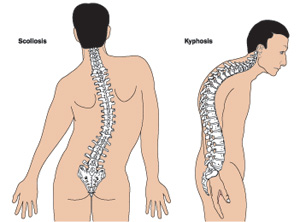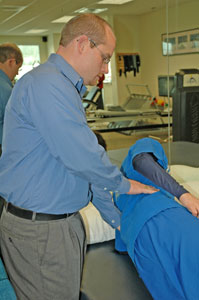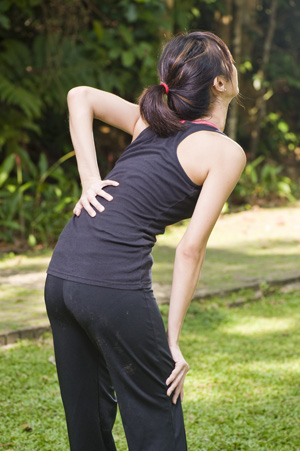What is scoliosis?
 Scoliosis involves an abnormal curvature of the spine, in which the vertebrae
twist like a bent corkscrew. The exact cause of scoliosis is unknown.
As much as 1-4% percent of the population is reported to have this condition.
Scoliosis is more common in females than males and most often affects
adolescents between the ages of 10 and 18.
Scoliosis involves an abnormal curvature of the spine, in which the vertebrae
twist like a bent corkscrew. The exact cause of scoliosis is unknown.
As much as 1-4% percent of the population is reported to have this condition.
Scoliosis is more common in females than males and most often affects
adolescents between the ages of 10 and 18.
About
scoliosis in adolescents
Scoliosis most often attacks adolescents between the ages of 10 and 18 and is more commonly seen in females than males. A child's likelihood to develop scoliosis is much higher if their parent or a sibling has it. Scoliosis can also develop over time in mid- to late childhood, usually before puberty. In other cases, the disease is congenital, meaning a person is born with a vertebral abnormality that causes it.
When scoliosis develops in girls prior to their first menstrual cycle, it is more likely to progress. When the onset occurs after the first menstrual cycle, the progession of the scoliosis is likely to reach a stopping point.
Symptoms
To diagnose a child with scoliosis, have them can touch their toes. If there is an imbalance in one or both shoulder blades, the waist or the ribs, scoliosis may be present. Pediatricians often screen for scoliosis, and there are school-screening programs as well.
Indications for scoliosis can be either visible or not. They include the following symptoms:
- Uneven shoulders or ribs
- Uneven waist
- Predominant leaning to one side
- Elevated hips
- Prominent shoulder blade(s)
According to the National Institute of Arthritis and Musculoskeletal and Skin Diseases, scoliosis may be genetically linked, so it is a good idea to have your orthopedic specialist screen your child yearly for scoliosis, if he or she has a parent or sibling with the disorder.
Treatment
What if happens if your child is diagnosed with scoliosis? Treatment options typically vary from case to case. Sometimes, treatment called "watchful waiting" is recommended when the condition is mild and does not seem to be worsening. If X-rays taken two to three times a year show no changes, no additional treatment is needed.
In most cases of scoliosis, physical activity is encouraged since it helps to strengthen muscles and ligaments surround the spine and increases flexibility. Formal physical therapy may be prescribed to some adolescents with scoliosis.
If scoliosis seems to be getting progressively worse, a brace may be prescribed. The brace is worn either at night or during most of the day until the child stops growing. In severe cases where the spine curves into the internal organs such as the lungs and the heart, or if the deformity is so large the health of the spine is at risk, surgery may be necessary.
Click the following link for more information on orthopedic disorders.
